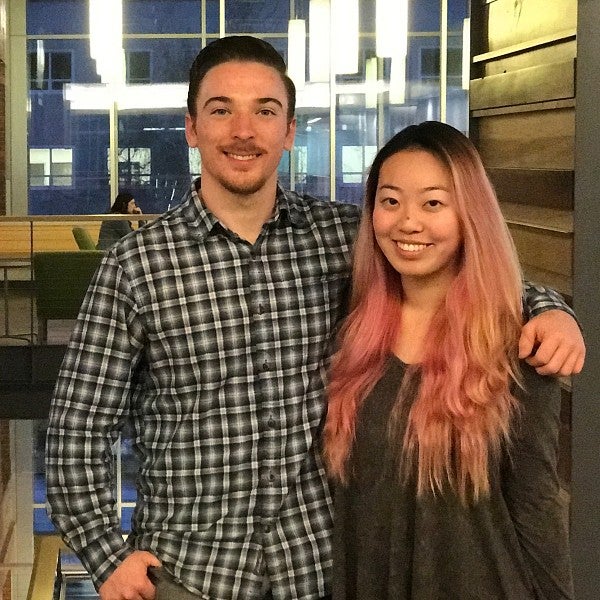
Story and photo by Nikki Kesaris
UO School of Journalism and Communication professors are always looking for new challenges to give their students. Over fall term, they found a new source of challenges: Ketchum Mindfire.
Mindfire is an exclusive new program that invites graduate and undergraduate public relations students to test their creative skills on actual client jobs. The worldwide PR agency Ketchum presents real-life challenges from some of its 500 clients to students. And the students compete to come up with the best solution.
In return for their work, student winners receive a cash prize and put themselves in the running for future internships and even jobs.
The client and its Ketchum account team review all submissions and decide which student idea would be the best for their needs and objectives. Highly engaged students who participate on a regular basis are eligible for an informational interview with a senior-level Ketchum executive.
Ketchum began Mindfire six years ago to bring fresh perspectives to their clients from PR students, who know one of their target audiences — millennials — well. Ronald Tolson, Ketchum’s creative platforms manager, is very selective when choosing universities to participate in Ketchum Mindfire. The SOJC was one of only a few journalism and communication schools selected to participate in the Mindfire challenge.
“When seeking out innovative, insightful and passionate universities to partner with, my research led me to the University of Oregon SOJC,” Tolson said. “I was impressed by how the university has consistently led undergraduate programs around the nation, winning national recognition in journalism, advertising and public relations. As a leading institution in the future of journalism and communication education for the last 100 years, I concluded it would be a privilege to partner with the University of Oregon SOJC.”
For the Mindfire challenge, SOJC PR professors select students to receive a challenge from one or two of the many Ketchum clients. The challenge includes an assignment overview, a creative strategy, what the client needs and the target audience. Students use all that information to come up with an innovative idea, which they submit on the Mindfire site, along with their inspiration and the impact they think the idea will have for the clients.
Assistant Professor Autumn Shafer is a big advocate for the program. Every term, she recommends that her J-494 Strategic Communication Research Methods students log on to the Ketchum Mindfire site and try their hand at challenges. Even if they don’t win, she believes the exercise is a great way to spur innovative thinking.
“Bringing Mindfire into the classroom gives students a peek at the strategic challenges they'll face in their careers,” said Shafer. “And it allows students to see how research can be applied for a strategic purpose.”
This was the first term SOJC Instructor Kathryn Kuttis used Ketchum Mindfire for her J-350 Principles of Public Relations class, and she found it was worth the extra work for her students.
“The hands-on challenge lets students experiment with concepts we discuss in class and use their own ideas, personas and experience to solve PR challenges for actual clients,” she said. “It’s a win-win for us and Ketchum, who gets all our best thinking.”
As it turns out, SOJC PR students are really good at the Mindfire challenge. Two students have won challenges so far, and three more have earned honorable mentions.
Erika Goto, a student in Shafer’s Strategic Communication Research Methods class, entered a challenge to promote the launch of a new smartphone using a creative idea inspired by millennials’ love for sharing photos.*
“Millennials are constantly thinking and searching for the next photo to post or the next status to update,” Goto wrote. “The idea was inspired by serving the needs of the target audience through providing a real-life example of what their photos could look like and making it easy for the millennials to connect with the campaign.”
Ryan Asbury, a Lindquist College of Business marketing student in Kuttis’ Principles of Public Relations class, won a challenge for a major nature advocacy and media organization. He suggested using social media and television to showcase what it’s like to live in a place that’s different from your own.
“The real-life experiential learning supplemented my class work by giving me a creative way to incorporate and synthesize concepts I learned in my PR class and use them in a real-world scenario,” said Asbury. “Mindfire offered me a fantastic challenge to push myself to think critically and pragmatically to provide real solutions to real client problems.”
The three students who earned honorable mentions for their innovative ideas in fall term are Emi Purice, Gina Safford and Carolyn Agrimis.
*For confidentiality purposes, we can’t disclose specific student ideas for the Ketchum Mindfire challenge or the names of Ketchum’s clients.
Nikki Kesaris is a junior studying public relations at the SOJC. This is her second year writing for the SOJC Communication Office. In addition to working in the Communication Office, she is also the vice president of media and marketing for the PanHellenic Board of Fraternity and Sorority Life and an account executive for Allen Hall Public Relations.
